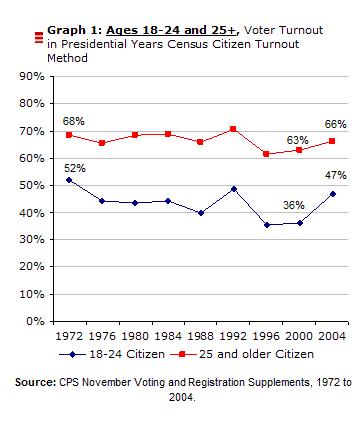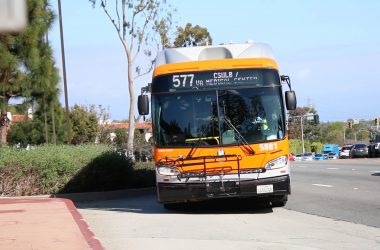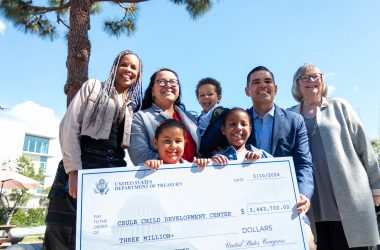The national numbers of Americans ages 18-24 voting in presidential elections hasn’t topped 50 percent since 1972, but many predict that this record may be topped tomorrow.
“A lot of people feel their vote doesn’t count,” said Donald Pogue, a Cal State Long Beach history major who voted early in Orange County. “But what right do you have to complain [about the outcome] if you didn’t vote?”
Youth voting reached a record low in the 1996 presidential election, according to the Center for Information and Research on Civic Learning and Engagement (CIRCLE). That percentage had jumped 12 points by the end of the 2004 election, and the upward trend is expected to continue with this election.
The reasons for the historically low proportion of youth voters are anyone’s guess, according a CSULB political science professor Lewis Ringel in an e-mail.
“It could be that a great number of younger voters do not have financial assets and do not get that politics affects them,” Ringel said. “It could be they feel that their vote does not count — a fairly rational feeling as it often turns out … It could be that they often feel content or not ready to vote. It could be that their family did not stress voting.”
Mary Caputi, a CSULB political science professor, sees voter apathy as a more pervasive phenomenon.
“I think it’s more an American trend than a youth trend,” Caputi said of voter turnout rates.
Expectation of a rise in youth voter turnout is being attributed to the existence of pressing national issues and the utilization of online media by both campaigns.
“Because 18 to 25-year-olds get the reputation of not voting, campaigns do not necessarily design campaigns with them in mind,” Ringel said.
But attempts from both camps to reach younger citizens through the Internet show that campaigns may be rethinking this strategy.
“The role of technology has been very important in bringing youth into the political process,”said Victor M. Rodriguez, Chicano-Latino studies professor and department chair, in an e-mail.“Given the level of youth involvement in the Obama and McCain campaign[s], it seems very likely that the youth vote will reach new heights this Nov. 4.”
Others attribute students taking notice of national issues as the main force behind mobilization.
“Younger voters — and all voters — are energized this time around because the stakes are so high,” said Shira Tarrant, a women’s studies professor, in an e-mail. “We’re at war, the economy is tanking, Wall Street greed is becoming obvious, people in power have taken us for a ride — and younger voters are sitting up and taking notice. Younger voters are wondering what their college degrees will be worth and why their friends are dying in Iraq. They have questions and want a change.”
Caputi said that, judging by the interest and excitement of students in her classes, she foresees a large youth voter turnout this year that will have a “substantial effect on the election.”
George Miranda of the L.A. County Registrar’s office said he expects young voter turnout to be much higher than it was in 2004 when, according to CIRCLE, 46 percent of California citizens ages 18 to 29 voted in the presidential election.
“What we’re seeing this year is a mobilization of young people in even greater numbers than in 1992, the year then-Arkansas Gov. Bill Clinton used the youth vote to help him defeat incumbent President George H.W. Bush,” Associate Professor of journalism Chris Burnett said in an e-mail.
According to CIRCLE, nearly half of U.S. citizens ages 18 to 24 voted in the 1992 election.
“We’re likely to see that record percentage surpassed this year,” Burnett said.
In an effort to ensure CSULB students would be eligible to cast informed votes on Election Day, Associated Students, Inc. organized a non-partisan campaign called Raise Your Voice.
As part of the campaign, ASI members set up voter registration tables on campus, held debate-viewing parties and invited supporting and opposing views of California’s propositions to come speak on campus. At the campaign’s end, Raise Your Voice had registered 1,460 students.
Through all of this, student political organizations on campus remained relatively quiet.
The Student Life and Development office is still waiting for club registration paperwork from the College Republicans, College Democrats and Campus Conservatives, while the Campus Progressives are one of the only registered on-campus political groups.
The Campus Progressives held an information session regarding state propositions and the Conservative Student Union held a “Yes on [Proposition] 8” rally on campus last week.
As with the 2004 election, students, faculty and staff will have the ability to vote on campus at a polling station that will be located in the University Student Union room 205.
Campus-goers will be allowed to vote in room 205 even if it is not their designated polling place, and voters will be able to turn in absentee ballots to the polling place if they have not already mailed them in.
However, Kim Hinckson, the assistant director of student involvement and leadership, encourages students to use their home polls if possible, because the on-campus polling station ballots are provisional and therefore will not be counted right away. Voters registered in L.A. County can find their designated polling locations at lavote.net.
The polls will be open from 7 a.m. to 8 p.m. and new voters may be required to show a state-issued picture ID, according to Hinckson. In 2004, the on-campus station had “long lines for hours,” Hinckson said.
“In the past few presidential elections, the youth vote hasn’t actually been mobilized,” Tarrant said. “But this time a slew of younger voters actually registered and first-time voters are ready to come out and be counted. Now what needs to happen is for all registered voters to actually see it through.”
Mobilize.org — a non-partisan organization that aims to get young voters involved in politics – has organized a Democracy 2.0 campaign to help continue youth involvement after Nov. 4..
“There is a lot more than meets the eye at stake. The Supreme Court. The perception of women in the future. The perception of the power of youth. The image of the United States. This is perhaps the most historic election in my short lifetime, and I am sure many of my counterparts could say the same.” said the organization’s Chief Information Officer Christina Gagnier via email interview.
Gagnier encourages young voters to take advantage of “the wealth of information online,” and added that there are plenty of unbiased reports and individual opinions.
“They need to mobilize and show up where the decisions get made.” said Gagnier. “Anyone can email a legislator, anyone can set up a meeting.”
“One of the most important things we can get our students to do before they graduate… is to get our students to understand their role in a democracy.” said CSULB President F. King Alexander.
“Candidates react to two things,” Alexander said. “They react to groups that vote, and they react to people giving them money … Students don’t have money to give them, so the only leverage students have on these issues is their ability to vote whenever they have the opportunity to.”




